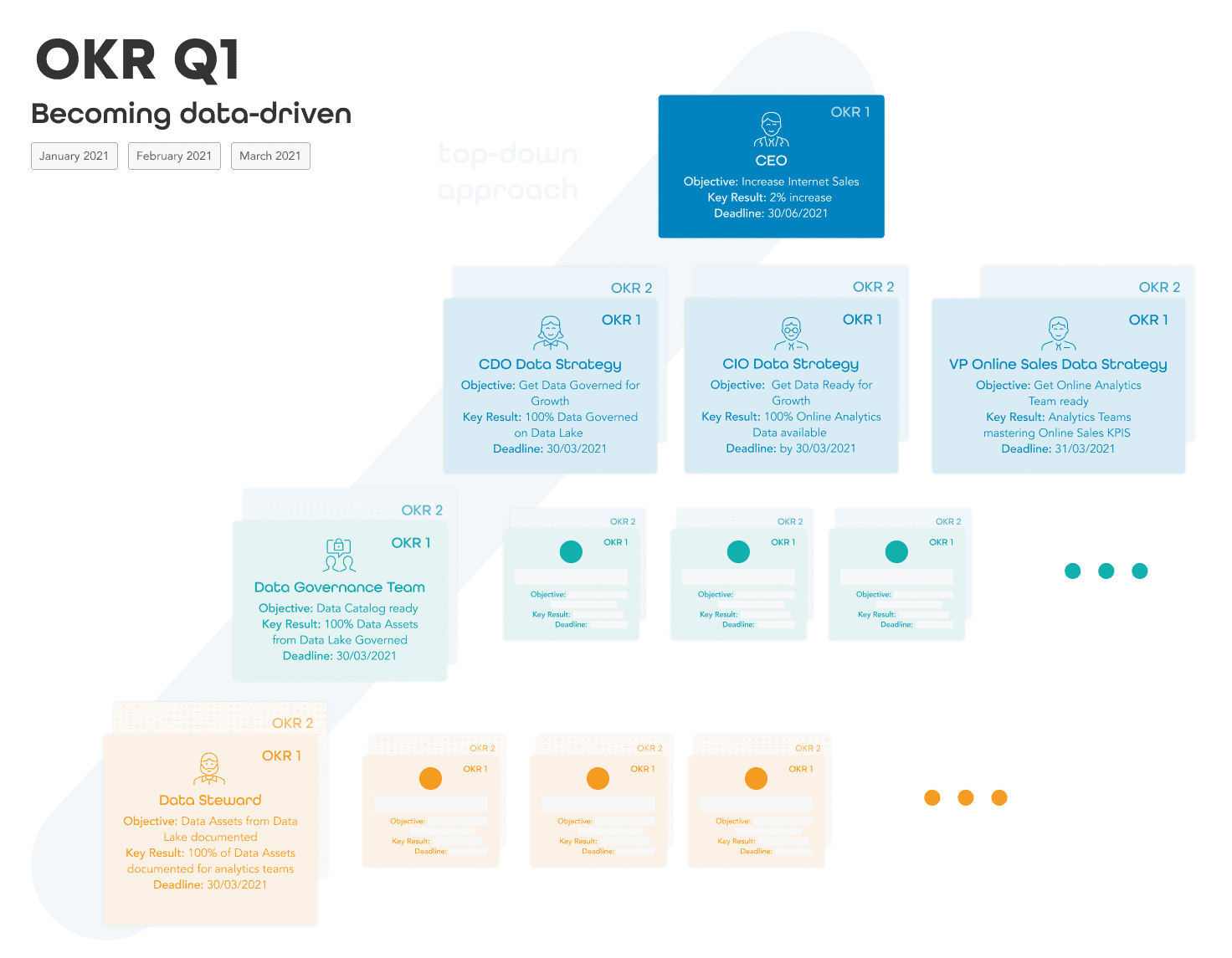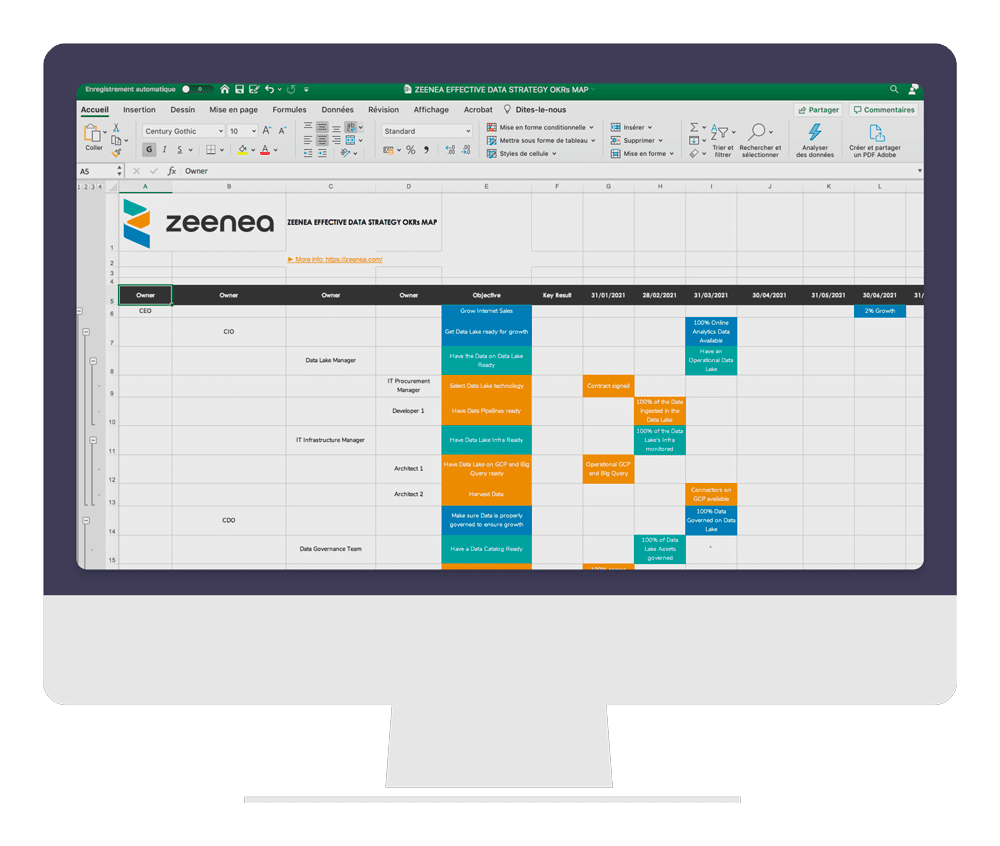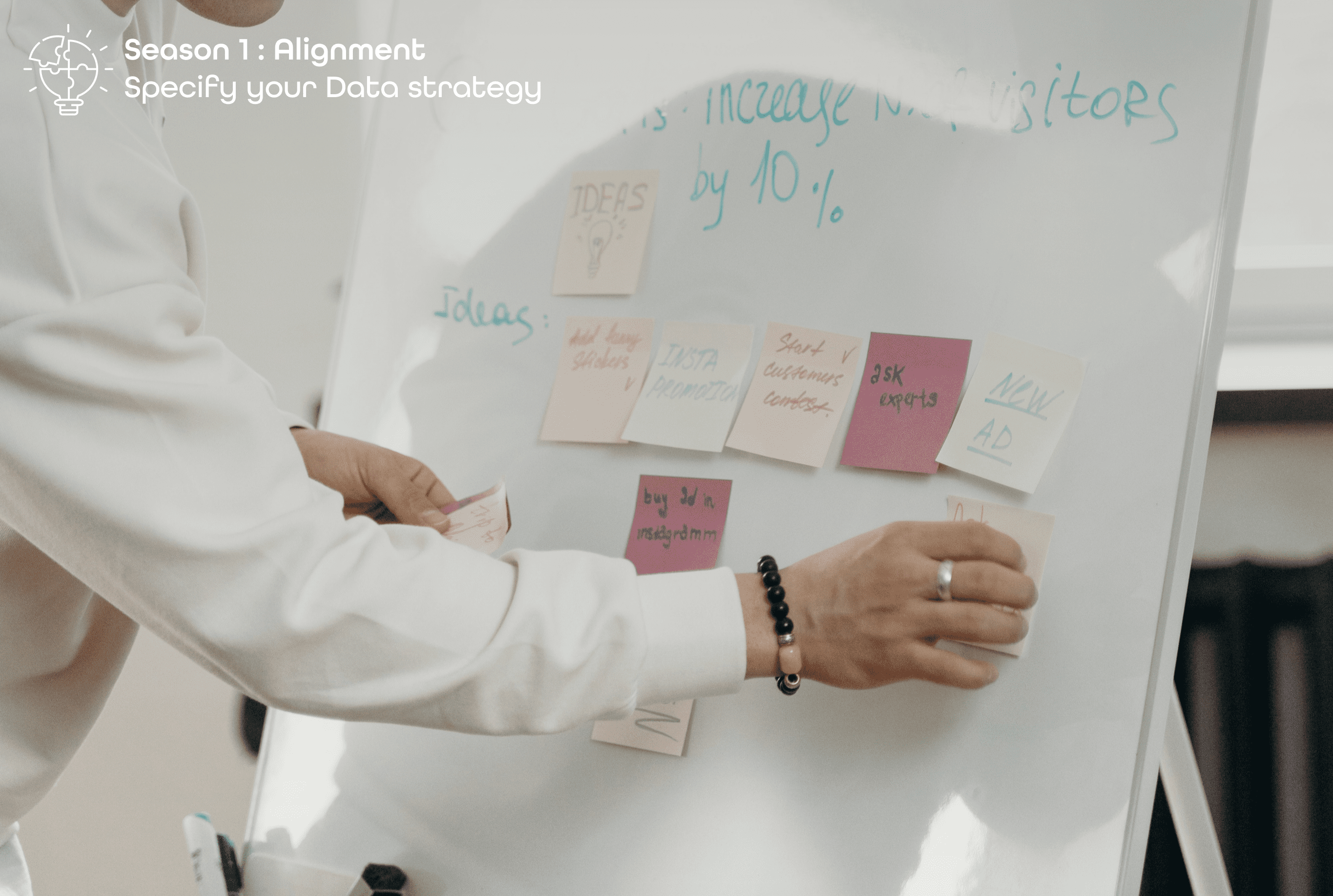This is the second episode of our series “The Zeenea Effective Data Governance Framework”.
Split into three seasons, this first part will focus on Alignment: understanding the context, finding the right people, and preparing an action plan in your data-driven journey.
This second episode will give you the keys on how to put in place an efficient enterprise data strategy through the setting up of Objective Key Results.
Season 1: Alignment
- RUnderstand the context
- RGet the right people
- RPrepare for action
S01 E01
Evaluate your Data maturity
S01 E02
Specify your Data strategy
S01 E03
Getting sponsors
S01 E04
Build a SWOT analysis
Season 2: Adapting
- RCreate your personas
- RIdentify key roles
- RSet your objectives
S02 E01
Organize your Data Office
S02 E02
Organize your Data Community
S02 E03
Creating Data Awareness
Season 3: Implementing Metadata Management with a Data Catalog
- RGet to know your data
- RIterate your data catalog
S03 E01
The importance of metadata
S03 E02
6 weeks to start your data governance journey
In our previous episode, we addressed the Data Maturity of your company through different angles.
In the form of a workshop, we shared our Data Governance Maturity Audit which enables you, through the Kiviat Diagram, to establish your starting point.
>> DOWNLOAD OUR DATA GOVERNANCE MATURITY MATRIX <<
In this episode, we help you define your company Data Strategy effectively.
What is the first step in defining your data strategy?
We recommend that you use the OKRs (Objective Key Results) framework to build your data strategy efficiently.
Before stepping into the topic itself, let’s delve into what OKRs mean, how they are built and then share some useful tips with you.
What exactly are OKRs?
Here, an “Objective” is something which you want to achieve (and) that is aspirational for all employees. A “Key Result” is how you plan to measure quantitatively.
We recommend you limit to 3 the number of Key Results per Objective.
There are many benefits to putting in place enterprise-wide OKRs. Their 5 key benefits are:
- More focus
- More accountability
- More engagement
- Better alignment
- More transparency
In the Zeenea Effective Data Governance framework, OKRs are cascaded, resulting in Key Results from the Executives involved in the Data Strategy to individuals involved from an operational perspective. Whilst Zeenea believes in a “bottom-up” approach, the OKR setting exercise is a “top-down” approach.
It is very important that, at each level, any one individual is able to understand the OKRs at the upper levels and how his or her OKRs contribute to the overall company Data Strategy.
We recommend you set up a reasonable deadline for each OKR. By proceeding this way, all deducted OKRs will be consistent with the deadlines from the highest levels. We also recommend you constantly share, display and explain the OKR Map to all the stakeholders.
This way, you will ensure engagement, alignment and transparency.
We suggest you negotiate the OKRs, especially their deadlines, rather than imposing them.
An example of setting up OKRs in your company
You can start with CEO OKRs on the Data Strategy if he/she is involved. At the highest level, one OKR will result in one dedicated OKR map.
On the lower levels, you can have several key results per team or employee..
For example, let’s take a CEO with 3 OKRs that impact the Data Strategy as shown below:

Then, working from the top level OKRs, you will be able to deduce the OKRs for CXOs and Top Executives like the Chief Data Officer, the Chief Information Officer, the Chief Product Officer, the VP of Sales, and so on.
For each Executive, there will be OKRs assigned to those reporting directly to them (such as heads of Analytics, heads of IT Architecture, heads of HR, etc), followed by OKRs for Teams (data governance data/IT architecture, analytics, business intelligence, data science, etc.) and finally, OKRs carried out by individuals, as shown.
Now take the OKR1 from the CEO, which relates to increasing online sales by 2% by 30/06/2021.
This OKR map shows the cascade of related OKRs carried out by C Levels and executives, teams and individuals resulting from the CEO OKR1.

As you can see in the OKR map above, we take into account the deadlines at all levels, resulting in a monthly overview of individual OKRs.
As an example, as described, The CEO OKR1 generates OKR1 for the CDO which consists of the following:
- Objective: Have the data catalog ready for the Data Lake
- Key Result: Have 100% of their data assets coming from the Data Lake governed
- Deadline: March 30th, 2021
And for the level below, a data steward carries the following OKR1
- Objective: Have all of the data assets from the Data Lake documented
- Key Result: Have100% of the data assets available for the analytics teams
- Deadline: March 30th, 2021
Tips on how to best set up your OKRs in the long run
We recommend you follow OKRs every quarter for the levels 1 and 2, and then more frequently at the team and individual levels.
Any change in the deadlines may have an impact at a higher level. Rather than impacting the chain of OKRs, we suggest adapting the impact of an OKR by reducing its scope as an MVP as much as possible in order to keep the pace.
Some other tips include:
- Select one OKR at the CEO (or a lower) level and practice before generalizing the OKRs practice,
- Consider the OKR practice as an OKR in itself and monitor it,
- Appoint one person in charge of the implementation of the OKRs to make sure that the team follows the agreed upon OKRs practices. That person will coach the team on the OKR processes and will administer the OKR tools (you can find some here).
Start setting your OKRs for your company’s data strategy!
The Zeenea Customer Success Team and Professional Services will help you initialize the OKR Map best suited to your Data Strategy. You will benefit from our expertise in data-related topics, especially in data governance/cataloging.
Typically, a Data Governance project, in which Zeenea is involved, may generate between 2 to 10 workshops (the duration of each workshop varies between 2 hours to half a day) in order to draft and initiate the Corporate Data Strategy for the first 3 to 6 months.
Don’t miss next week: S01 E03 – Get Sponsorship.
Copyright Zeenea 2021, all rights reserved.









